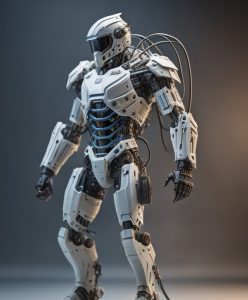
Many of us have heard the term “rehabilitation,” which refers to measures aimed at restoring body functions lost after injuries, fractures, etc. The most difficult are the injuries caused by strokes or spinal cord injuries, which often leave patients bedridden and wheelchair-bound. That is why doctors are now increasingly using “exoskeletons” to help them learn to walk again.
The exoskeleton is an external framework that replicates human biomechanics to enhance muscle strength.
The creation of humanoid devices was aimed at helping disabled people who could not move on their own. The anthropomorphic works were first designed in the early 1980s at the Institute named after A.A. Kuznetsov. St. Michael’s Hospital in Belgrade for patients with lower limb paralysis. Today, we can observe the demand for active exoskeletal systems, which are classified according to various features. Thus, these devices are divided into two groups based on the type of energy source and drive principle:
- active;
- passive.
by localization:
- for the upper extremities;
- for the lower extremities;
- an exoskeleton suit.
by weight:
- lightweight (up to 5 kg);
- medium (5-30 kg);
- heavy (over 30 kg).
by the number of functions:
patient’s mobility:
- mobile;
- fixed.
Algorithm of the exoskeleton for rehabilitation
The “external skeleton” is an intelligent electronic system that is controlled by the patient, sending the necessary signals to his or her brain. The desire to take a step is formed in the form of a nerve impulse in the brain and sent to the muscles of the limbs through the spinal cord. It is this impulse that the exoskeleton picks up and helps the patient take a step. After repeated repetition, new strong nerve connections are formed.
The main advantages of robotic exoskeletons
- Improved mobility. The device provides a greater range of motion and stability for people with disabilities, as they can move with greater independence. The mechanical skeleton sensors detect user movements and adjust accordingly.
- Improving the quality of life. They provide patients with a new level of independence and freedom, which has a positive effect on self-esteem and increases self-confidence. The result is greater social engagement.
- Reducing pain and fatigue. They allow users to perform everyday tasks with ease, reduce pain, and reduce the risk of falls and other injuries.
- Improved physical and cognitive functioning. The device helps to restore strength and muscle memory. In addition, users of robotic exoskeletons have reported improved cognitive functions, including enhanced memory and problem-solving abilities.
In addition, medical exoskeletons can provide accurate data on patient progress, offering valuable feedback for clinicians to customize treatment plans. Thus, exoskeletons are not only therapeutic tools, but also powerful data-driven devices for personalized medicine in the field of physical rehabilitation.

